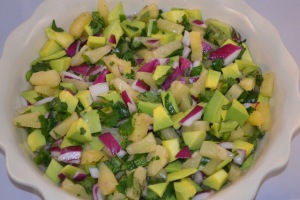Pide is basically the Turkish equivalent of pizza. The bread is super-thin but rises quite well. There is no sauce.
Ingredients: (makes 4 pide bases):
2 teaspoons dried yeast
1 teaspoon sugar
150 ml water or milk
300 grams flour (approx)
1 teaspoon salt
2.5 tablespoons olive oil
Directions:
First off, warm the water or milk. It must not be warmer than body temperature, otherwise the yeast dies. Just as you would with a bath, use a (clean) elbow to check the temperature if in doubt! Mix in the yeast and sugar. Sift the flour into a large bowl, add the salt, then stir in the yeasty liquid, and add the olive oil.
Mix together until all the ingredients are well blended, then knead the dough for about 2 minutes (the more you knead, the more flexible the dough becomes). Put the dough back in the bowl and dust some flour lightly over the top. Then put a plastic bag over and around the bowl and leave it in a warm place (like an airing cupboard or boiler room) for around 20 minutes. The plastic bags stops the dough from drying out and aids the proving process.
Whilst the dough is proving, you can get started with your topping.
Once the dough has raised (it should be about 50 % larger than before), take it out and knead well to get rid of any air bubbles. You may have to add a little flour to stop it from sticking, but do use sparingly so that the dough remains nice and moist.
Cut the dough into four equal chunks and knead each of them well. This helps develop the arm muscles ready for your next bout of Turkish wrestling. Place one of the pieces on a lightly floured surface, and use a rolling pin (substitute a wine bottle – carefully – if you don’t have a rolling pin to hand) to roll it into an elongated oval.
Spread your desired filling on top of the pide, and crimp the edges up 1-2 centimetres, so your pide has a shape rather like a large stuffed aubergine/eggplant, or a flattened boat. Brush the sides and edges with olive oil, then bake for about 15 minutes at 250 degrees Celsius.
We love spicy, meaty pides. Normally they’re very simple, like this beef variation, which is also the basis for the very thin, round variety of pide in Turkey, known as lahmacun.
1 peeled and diced tomato
3 tablespoons chopped parsley
1 pepper (you could use a sweet one, or if you like it fiery, use a chilli pepper as well)
Mix all the ingredients together in a large bowl, spread on top of your pide. Bake in the oven.
If you fancy trying something more exotic and unusual:
125 grams finely diced lamb
Warm a saucepan and fry the onions until they are transparent. Add the mince and diced lamb and fry until all the meat is gently browned. Add the wine and enough water to cover the meat. Let the mixture cook for a good hour or more. Then add the garlic, cumin and paprika, and let the mixture cook for another 15 minutes or so. If any liquid remains, decant it off. Your topping is ready! Simply apply and bake in the oven.
Sujuk (Spicy salami) Pide
25 slices sujuk (or spicy salami sausage)
80 grams grated mozzarella cheese
1 long green pepper sliced and de-seeded
Apart from the pepper, mix the ingredients together and spread on top of your pide. Then add the slices of green pepper for a decorative and tasty finish. Bake in the oven.
100 grams feta cheese (crumbled)
100 grams mozzarella cheese
Fry onions in olive oil until transparent, add garlic and fry for a little longer. Add the tomatoes, and let the mixture cook until most of the juice has evaporated. Spread the sauce on the pide.
Throw on some black olives, some feta cheese, and some mozzarella. Add oregano and black pepper. Bake in the oven.


